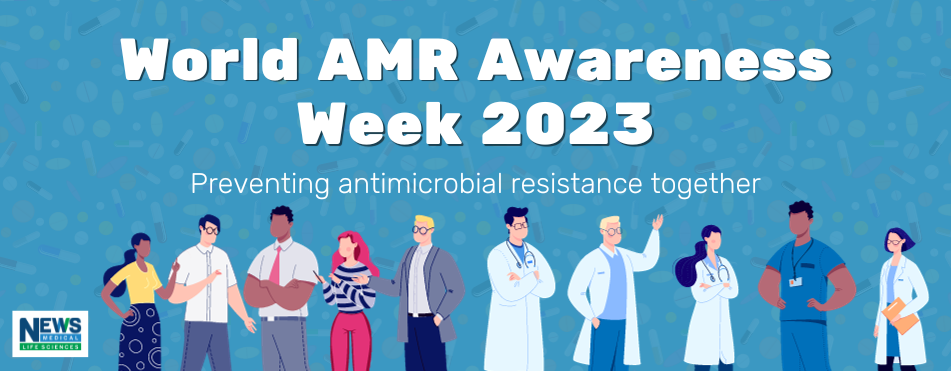 The discovery of antibiotics revolutionized patient care; however, the overuse of antibiotics throughout the world has led to the emergence of antimicrobial-resistant organisms that continue to pose significant threats to global health and economic well-being. In addition to the adoption of various public health policies to reduce unnecessary antibiotic prescriptions, various vaccine candidates have also been developed to combat the growing problem of antimicrobial resistance.
The discovery of antibiotics revolutionized patient care; however, the overuse of antibiotics throughout the world has led to the emergence of antimicrobial-resistant organisms that continue to pose significant threats to global health and economic well-being. In addition to the adoption of various public health policies to reduce unnecessary antibiotic prescriptions, various vaccine candidates have also been developed to combat the growing problem of antimicrobial resistance.
 Image Credit: BaLL LunLa/Shutterstock.com
Image Credit: BaLL LunLa/Shutterstock.com
Introduction to antimicrobial resistance
Understanding AMR
Antimicrobial resistance (AMR) refers to the evolution of microorganisms like bacteria, fungi, and viruses through mutations or genetic transfer to survive exposure to a previously effective antimicrobial agent. In 2019 alone, AMR was responsible for over 4.95 million deaths, which exceeded the deaths due to human immunodeficiency virus (HIV) and malaria combined. By 2050, the World Health Organization (WHO) estimates that AMR will cause up to 10 million deaths each year.
AMR is largely due to the overuse and misuse of antimicrobial agents, particularly in low- to middle-income countries (LMICs) where many individuals will self-diagnose their illnesses and purchase over-the-counter antibiotics when they are not needed for treatment. Many physicians throughout the world also unnecessarily prescribe lengthy courses of antibiotics due to a lack of appropriate diagnostic tools to confirm a bacterial infection or to avoid dissatisfaction from patients demanding antibiotic treatment.
In addition to the direct effects of AMR on patient care, it is also associated with significant economic costs. Within Europe, AMR has been attributed to over nine billion euros, whereas the United States Centers of Disease Control and Prevention (CDC) estimate that AMR contributes to $20 billion USD in direct healthcare costs and $35 billion USD in loss of productivity each year.
The role of vaccines in AMR prevention
Vaccines and AMR
Vaccines are considered to be highly effective tools in the fight against AMR. Vaccines significantly reduce the overall burden of infectious diseases caused by both bacterial and viral infections. In fact, vaccines against viral infections, particularly those affecting the respiratory system, reduce the inappropriate use of antibiotics, thereby limiting the spread of resistant pathogens.
Bacterial infections are common secondary complications following certain viral infections and may even lead to viral-bacterial superinfections. Thus, vaccination against viral pathogens directly reduces the risk of these secondary bacterial infections that may be antibiotic resistant.
In addition to the indirect benefits of vaccines on AMR, several vaccines have also been developed to specifically target bacterial strains that have become resistant to modern antibiotics. For example, several vaccines have already been developed to target Streptococcus pneumoniae, Haemophilus influenzae type b, and Salmonella enterica serotype Typhi (S typhi).
Vaccine success stories
Impact of vaccination
Since 1983, several pneumococcal polysaccharide vaccines have been developed and approved for use in children. These vaccines have significantly reduced the incidence of infections caused by both drug-susceptible and drug-resistant S. pneumoniae infections, with observational studies suggesting that up to 84% of invasive pneumococcal diseases in children younger than two years of age were prevented in the United States alone in the first five years these vaccines were introduced.
Current estimates indicate that pneumococcal conjugate vaccines (PCVs) have prevented up to 23.8 million infections in children younger than five years of age in LMICs. In the absence of both PCV and rotavirus vaccines, researchers estimate that that these pathogens would be responsible for 56.9 million and 47.9 million cases of antibiotic-treated infections, respectively. However, despite the availability of these highly effective vaccines, global vaccine coverage remains low at about 40% in children under five years of age.
To date, over 20 vaccines have been developed and approved for use against S. typhi. Within Pakistan, typhoid conjugate vaccines (TCVs) have been particularly successful to mitigate local outbreaks of drug-resistant S. typhi infections. Current estimates indicate that routine immunization with TCV by nine months of age with additional booster doses would prevent 21.2 million multi-drug resistant typhoid infections and over 342,000 deaths throughout the world.
Vaccines and antimicrobial resistance
Challenges and myths
Vaccine misconceptions
To date, vaccines have saved millions of lives throughout the world. Despite these benefits, vaccine hesitancy has emerged as a significant public health issue that has led to the re-emergence of previously controlled diseases like measles. Although the factors contributing to vaccine hesitancy are complex, misinformation is often spread through social media and other outlets that willingly ignore the wealth of scientific evidence supporting the safety of currently approved vaccines.
Following the publication of a problematic paper proposing a link between vaccines, particularly the measles, mumps, and rubella (MMR) vaccine, and autism, MMR vaccine coverage significantly declined in many developed nations including the United Kingdom. This paper, which was ultimately retracted due to its lack of appropriate controls and biased study design, led many researchers to conduct large epidemiological studies throughout the world which have substantively affirmed that vaccination, including with the MMR vaccine, does not have a correlative or causative link to autism spectrum disorders (ASDs).
Another issue that many vaccine-hesitant parents raise is concerns regarding the number of vaccines that children receive, particularly those under two years of age. In some regions of the world, over 30 doses of vaccines that protect against 20 different diseases will be administered to children within the first 24 years of life.
Importantly, the schedule and dosing of these vaccines have been based on various factors including the waning of maternal antibody levels during pregnancy, maturation of the immune system, and the vulnerability of young children to these potentially severe diseases. Furthermore, delaying or separating vaccines puts patients at unnecessary risks and has not been shown to confer any benefits to the child.
The importance of herd immunity
Herd Immunity and AMR
Effective vaccination coverage throughout a given population confers protection to members of the community who are not vaccinated or are not capable of mounting effective immune responses following vaccination. This phenomenon, which is widely referred to as herd immunity, can significantly reduce the transmission of AMR pathogens and limit the use of antibiotics in non-vaccinated individuals.
Herd immunity has already reduced the burden of various diseases throughout the world, including invasive pneumococcal disease. To this end, significant reductions in penicillin-resistant pneumococcal infections have been reported in all age populations, including those over 65 years of age, following the introduction of PCV7 and PCV13.
References
- Ding, D., Wang, B., Zhang, X., et al. (2023). The spread of antibiotic resistance to humans and potential protection strategies. Ecotoxicology and Environmental Safety 254. doi:10.1016/j.ecoenv.2023.114734.
- Frost, I., Sati, H., Garcia-Vello, P., et al. (2023). The role of bacterial vaccines in the fight against antimicrobial resistance: an analysis of the preclinical and clinical development pipeline. The Lancet Microbe 4(2); e113-125. doi:10.1016/S2666-5247(22)00303-2.
- Laxminarayan, R. (2022). The overlooked pandemic of antimicrobial resistance. The Lancet. doi:10.1016/S0140-6736(22)00087-3.
- Lewnard, J. A., Lo, N. C., Arinaminpathy, N., et al. (2020). Childhood vaccines and antibiotic use in low- and middle-income countries. Nature 581;94-99. doi:10.1038/s41586-020-2238-4.
- Geoghegan, S., O’Callaghan, K. P., & Offit, P. A. (2020). Vaccine Safety: Myths and Misinformation. Frontiers in Microbiology 11. doi:10.3389/fmicb.2020.00372.
- Jansen, K. U., Gruber, W. C., Simon, R., et al. (2021). The impact of human vaccines on bacterial antimicrobial resistance: A review. Environmental Chemical Letters 19(6); 4031-4062. doi:10.1007/s10311-021-01274-z.
Further reading
Last Updated: Nov 14, 2023